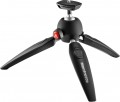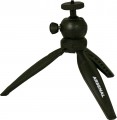Minimum height
The minimum height relative to the base at which the tripod base can be mounted.
The lower the minimum height, the better the tripod is suitable for macro and product photography; in addition, the range of height adjustment available to the user depends on this indicator. Note that for models with the ability to flip the boom (see below), the minimum height is given for the traditional position of the boom, platform up. And if the claimed minimum is significantly less than the length of the tripod when folded (for example, 15 cm with a length of 50 cm), this means that the legs can “spread” to a horizontal position or close to it, thus lowering the entire structure.
Maximum height
The maximum height from the base on which the tripod base can be mounted.
For desktop use (see "Installation"), a large height is not required, therefore, in most of these models, this figure does not exceed 20 cm — the only exceptions are some specific monopods. Accordingly, the difference in height between different desktop structures in most cases does not matter much. But in the floor models, the most "undersized" have a maximum height of about 40 – 50 cm, and the highest ones are able to open up to 2.5 m and even higher. In such cases, the choice should take into account the specifics of use. So, it makes sense to specifically look for a model at
150 – 160 cm if it is fundamentally important to install the camera at eye level (eye level is usually about 10 cm lower than a person’s height). At the same time, most camcorders and many cameras have swivel screens that allow you to comfortably look at the device from top to bottom; and even in the absence of such a screen, bending down to the level of the camera is not so difficult. And it makes sense to pay attention to tripods with a height of
170 cm and above mainly in those cases when shooting over heads is planned — for example, reports from public events.
Leg sections
The number of individual sections that make up the legs of a tripod or monopod shaft (see "Type").
In desktop models (see "Installation"), the legs are often not divided into sections at all, for such cases this parameter is not indicated at all. In turn, almost all floor tripods have several sections, and the number of the latter with the same maximum height can be different. Here it is worth considering that more sections means a smaller size of each of them and more compact dimensions of the tripod when folded; and a smaller number — simplifies the design, increases its reliability and reduces cost.
The most popular options nowadays by the number of sections are 2 pcs,
3 pcs,
4 pcs,
5 pcs,
6 pcs,
8 pcs.
Removable head
The ability
to remove the tripod head and replace it with another if necessary. This makes the tripod more versatile: for example, you can shoot panoramic images using a 2D head (see "Type of head"), and at the right time you can replace it with a ball head, which is more suitable for operational shooting. Detachable head is considered mandatory for professional tripods.
Body material (legs)
The main material used in the construction of the body or legs (depending on the type) of a tripod.
—
Plastic. The main advantage of plastic is its low cost, due, among other things, to ease of processing and suitability for creating parts of complex shape. In addition, this material can be flexible, have any colour, and even become transparent. On the other hand, its strength is significantly lower than other tripod materials; it is more than enough to work with light weight, however, plastic is not suitable for supporting massive equipment and creating long supports that are subject to significant bending loads due to the large length. Therefore, the main scope of this material today are
clamps and small table stands, including flexible design (see "Type").
—
Aluminium. Aluminium-based alloys have a combination of high strength and low weight, making them well suited for the construction of tripods of any format — including and classic full size. The cost of this material, however, is somewhat higher than that of plastic and steel, but not by much, and the mentioned advantages more than cover this drawback. Because of this, this material is the most popular in modern tripods, it is widely used in almost all types and price categories.
—
Steel. Steel is characterized by high strength — even higher than that of
...the aluminium alloys described above, at a slightly lower cost. At the same time, this material has a rather large weight. On the one hand, this contributes to stability, on the other hand, it makes it difficult to carry from place to place. And although the latter is relevant mainly for floor tripods (see "Installation"), however, even in compact desktop models, steel is still rarely used.
— CFRP. The most advanced of the materials used for modern tripods. Carbon fibre, or carbon fibre, is a composite composition of carbon fibers filled with a filler — usually a special resin. In terms of strength characteristics, this combination is comparable to steel, while this material weighs very little, which is especially useful for full-size tripods. Its main disadvantage is the high cost, which is why professional premium models remain the prerogative of carbon fibre. In addition, carbon fibre requires fairly careful handling due to its sensitivity to point impacts — cracks easily appear from them.
— Metal. This option is indicated in cases where the manufacturer, for one reason or another, did not specify the composition of the metal in the characteristics. Most often, this refers to aluminium or steel, the properties and features of the use of both are described above; however, other types of metal may occur. Anyway, when assessing the reliability and durability of such a tripod, it is best to focus on its price category.
— Carbon. Another name for the CFRP described above; used by some manufacturers for the sake of brevity and "solidity of sound".Support material
Support material — the lower part of the legs, in direct contact with the surface on which the tripod is placed.
—
Rubber. Rubber feet are perfect for hard surface applications. They securely stand on almost any material, do not slip and even tend to “stick” slightly, additionally holding the tripod in place. In addition, such supports do not damage delicate coatings such as parquet or polished wood, and they themselves, in turn, resist damage well, are not afraid of asphalt and other rough materials. For installation on the ground, viscous or loose material, rubber is somewhat worse than spikes, but this moment is rarely critical, and supports of this type are widespread in modern tripods.
—
Thorns. Supports in the form of rather sharp spikes are able to pierce into soft surfaces, securely fixing the entire structure on them. This option is perfect for installation on soft ground, sand or clay, hard snow, etc. At the same time, sharp spikes are not suitable for hard surfaces: they tend to slip and can damage soft materials. Therefore, in its pure form, this type of support is quite rare, more often a combination of spikes / rubber is used (see below).
—
Spikes / rubber. Supports in the form of spikes with removable rubber caps put on them. About both options separately, see above, and their combination makes the design as versatile as poss
...ible, allowing it to be adjusted to different types of surfaces. So, spikes are well suited for a lawn or beach, and if you need to move to the asphalt or go into a room, sharp supports can be covered with rubber caps. Due to this versatility, combo stands are very popular among floor tripods (see "Installation"), but it makes no sense to use them in tabletop models.
— Plastic. Supports, in many respects similar to the rubber ones described above; also designed for use mainly on hard surfaces, including delicate ones. One of the key advantages of plastic is its low cost. On the other hand, such supports are somewhat less reliable and durable than rubber ones, and are more prone to slip, which is why they are much less common.
— Magnetic. Supports with permanent magnets built into them, capable of “sticking” to magnetic surfaces and providing additional fixation reliability. They are used exclusively in table tripods, mostly flexible (see "Type") — it does not make sense to install such supports in a larger model. But in compact designs, the strength of the magnets can even be enough to hold a tripod suspended “upside down” along with the camera. On the other hand, it is quite rare to put tripods on metal, so this option has not received distribution.
— Wheels. Supports in the form of wheels, usually self-orienting (as in office chairs). They are rare, mainly in professional studio tripods for video filming: both the tripods themselves and the cameras mounted on them are quite massive, and it is easier to move the entire structure from place to place on wheels.
